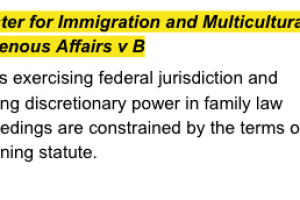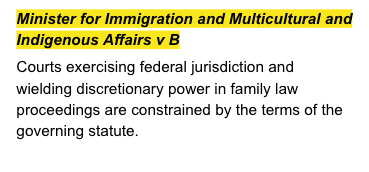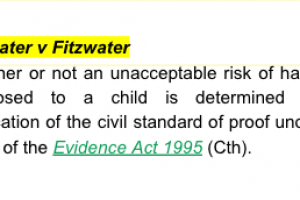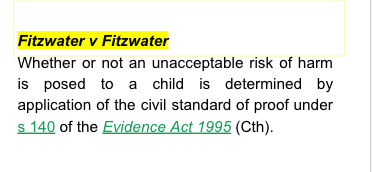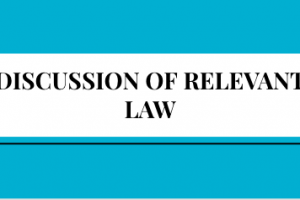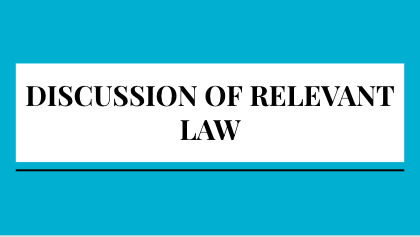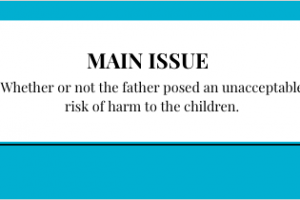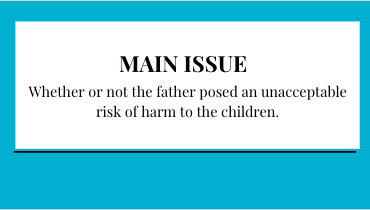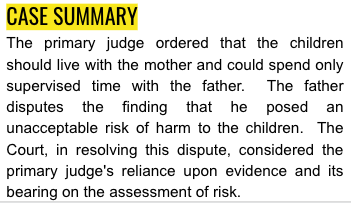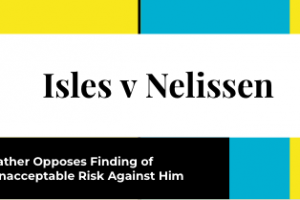- · 4850 friends
Father Opposes Finding of Unacceptable Risk Against Him Based on Tendency Evidence

Isles & Nelissen [2022] FedCFamC1A 97 (1 July 2022)

The primary judge ordered that the children should live with the mother and could spend only supervised time with the father. The father disputes the finding that he posed an unacceptable risk of harm to the children. The Court, in resolving this dispute, considered the primary judge's reliance upon evidence and its bearing on the assessment of risk.

Facts:
The appellant is the father, and the respondent is the mother. They are the parents of the four children. The eldest was aged 10 years at the time of judgment. In April 2018, when the eldest child was nearly seven years of age, he alleged that the father sexually assaulted him by penetrating his anus with a finger. There is no dispute the child actually made the allegation, because he made it in the presence of several adults and children, prompting the mother to challenge the father about the allegation at her home two days later on 20 April 2018, when he denied it.
The child was interviewed three times by police: first on 19 April 2018, when he made no disclosure of sexual abuse by the father; secondly, on 20 April 2018, when he did repeat the earlier allegation of his digital penetration by the father; and thirdly in November 2018, when he confirmed the alleged apology to him by the father on 20 April 2018. The father was charged with the child’s rape, but the prosecution was later withdrawn by the State Director of Public Prosecutions in June 2019 due to the “lack of specificity” in the evidence. The allegations against the father caused the mother to withhold all the children from him.
The father, dissatisfied with that situation, commenced proceedings under Pt VII of the Act in July 2018, seeking orders in respect of the children. Interim orders were subsequently made for the children to spend supervised time with the father. In September 2020, final consent orders were made for the children to live with the mother and to spend unsupervised time with the father following a period of graduated supervision, but those orders did not take effect. The designated representative of the State child welfare agency stepped in and commenced child welfare proceedings before a State magistrate, securing orders for the children to live with the mother and to spend only supervised time with the father.
The father commenced fresh proceedings under Pt VII of the Act, in response to which the child welfare agency agreed to participate as a party and abandon the welfare proceedings still pending before the State magistrate. The primary judge ultimately found out that the mother was induced to consent to the orders in September 2020, enabling the children to spend unsupervised time with the father, once she had been told by staff of the child welfare agency that they would never allow that to occur.
During the course of the litigation, the eldest child repeated his sexual abuse allegations against the father to third parties, including the single expert psychologist (at [87]–[88]), the Family Consultant (at [111]), and a paternal uncle (at [146]). The primary judge concluded the children should live with the mother and could spend only supervised time with the father.

Issue:
Whether or not the father posed an unacceptable risk of harm to the children.

Applicable law:
Evidence Act 1995 (Cth) s 140 - provides that the “case of a party” must be found proven if the court is satisfied of its proof on the balance of probabilities.



Analysis:
The primary judge correctly approached the two separate questions without conflation: on the one hand, whether or not allegations of abuse are proven on the balance of probabilities; and on the other, whether or not an unacceptable risk of harm is demonstrated, regardless of the finding made in respect of the frank allegations of abuse.
The primary judge inferred the existence of an unacceptable risk of harm to the children from a combination of facts and circumstances, including the elder child’s plausible but unproven allegations of sexual abuse by the father; the evidence of the father’s sexual interest in other adolescents; and evidence of the father’s interest in child exploitation material. Risks of harm are not susceptible to empirical proof, but a mathematical hypothetical will nevertheless illustrate how findings of “unacceptable risk” cannot be measured by the civil standard of proof.
From the way in which the order is couched, it purports to apply all of the excluded parts of the Evidence Act(1995) to all of the issues in the proceedings. That may not be what his Honour actually intended, but it is the objective effect of the order. The primary judge signaled an intention to apply the rules of evidence and to take and deal with objections as objectionable evidence arose. The father took no objection to the evidence adduced at trial.
In deciding whether or not the allegations of the father’s sexual abuse of the eldest child were positively proven, besides the direct evidence and inferences ordinarily available on that issue, the primary judge took into account as tendency evidence allegations about the father’s apparent past sexual interest in adolescents and his alleged interest in child exploitation material.
When taking that evidence into account, the primary judge found the father’s alleged sexual abuse of the eldest child still could not be proven to the civil standard of satisfaction. The father, therefore, suffered no prejudice, as no adverse positive finding against him followed from the admission and the reliance upon such evidence. Although the father may have disputed it, there was evidence adduced of his possession of child exploitation material on two different occasions, years apart in 2007 and in 2013.
Conclusion:
The appeal fails for lack of merit. The parties and the ICL were all recipients of grants of legal aid in the appeal. There should be no orders for costs.


